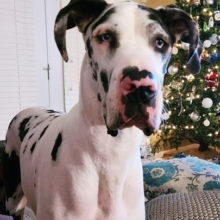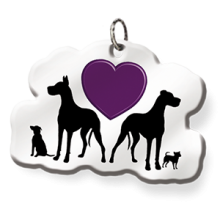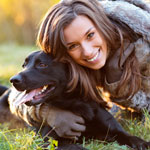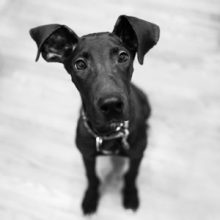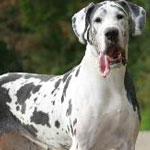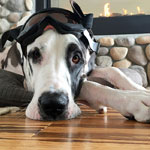We firmly believe in positive reinforcement, also known as reward-based training. Reinforcing good behaviors rather than punishing negative ones greatly increases the dog’s understanding of and likelihood to repeat the good behaviors. This is important for a couple of reasons:
- It builds a positive, trusting bond between you and your dog.
- It builds confidence in the dog instead of frustration, fear, or anxiety – all of which are associated with negative reinforcement.

Great Danes, in particular, are a sensitive breed. Any dog can easily react out of fear or anxiety, and we find that Danes are certainly no exception. They do best when taught with consistency, kindness, and patience.
Victoria Stilwell has a good article on the science of positive reinforcement training.
Be consistent.
This means every member of your household is on board, and you don’t confuse the dog by reacting differently at different times.
Find what your dog loves to work for.
Some will work for praise, some for treats, and others best for a particular toy.
End on a good note.
Don’t end a lesson in a frustrated or negative space.
We’ve teamed up with one of our trainers, Sally Said So Professional Dog Training of Raleigh, NC, to answer some common training and behavior questions for Great Danes or any new dog to your home.
It could take 2 weeks to one month to have the “honeymoon phase” wear off.
There’s not much difference training Danes or any other breed for that matter. They all have their own personalities and characteristics, but at the end of the day, it’s the same dog brain just wrapped in a different package!
Always take control. Dogs are natural-born leaders in most cases. Take control of new stranger introductions by introducing the dog on a leash and only when calm. An excited interaction will always get an excited reaction.
When we deal with rescues, there’s one ultimate thing to understand. Dogs are the way they are because of their past, but they don’t know it. They are not dwelling in the past and not anxious about the future; the dog is right now. Do not let the human compassion of what we think might have happened alter what decisions we make for the dog today. What they need is someone to take control so they don’t have to make any decisions.
Introducing a new dog to the existing dogs should always be on neutral territory. Most dogs settle things on the walk. Walk at distance, and on each pass go closer. They will be much more successful when given the time to greet calmly than in the full throes of excitement!
Crate training can be a breeze. Crate your dog multiple times a day for short periods of time. There should be no association of the crate and you leaving. That’s where separation anxieties are created.
Resource Guarding is a difficult problem to deal with. There are lots of reasons dogs guard objects. Always seek the assistance of a professional when it comes to Resource Guarding issues.

